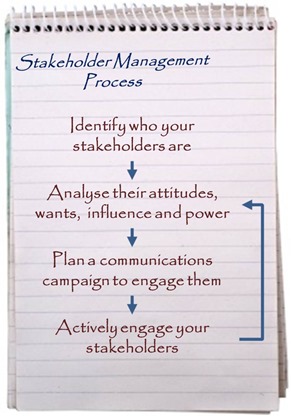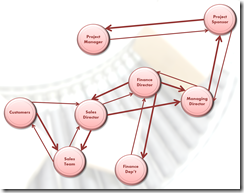Pocketblog has gone back to basics. This is part of an extended management course.
We are working through a series of blogs, looking at some of the essential models that a project manager will need. We will cover:
- The Project Lifecycle
- The Triple Constraint
- Stakeholder Management (here)
- The Critical Path
- The Gantt Chart
- Risk Management
The Stakeholder Management Process
Stakeholder management starts during scoping, to understand their varying needs and wants, and negotiate with them to balance stakeholders’ long shopping lists with your constrained resources. In the planning stage, you need to figure out how to win over – or at least pacify – the doubters and keep your supporters happy, so that throughout this stage and the implementation stage, you can engage with your stakeholders actively. In the evaluation stage you will need their perceptions if you want to create a full assessment of your project.
The broad process for managing stakeholders has four steps.
Stakeholder Plan
Build your plan for each stakeholder, based on your assessment of:
- what they want from you
- what you want from them
- what level of influence and power they have
- how supportive or sceptical they are
- … and any other factors
Your plan should contain:
- The messages you want to communicate
- The means by which you plan to communicate them
- What attitude to take (for example: consultative, informing, instructing, requesting…)
- The best time to deliver each message
- Who will be responsible for preparing and delivering each message
- How you will test whether the message has gone down as you intended
- How you will gather feedback from the stakeholder
Stakeholders are vital to your project. It is they, after all, who will pass the final verdict on whether it has a success…
or a failure.

From the Management Pocketbooks series:



![Emile_Durkheim[2] Emile_Durkheim[2]](https://www.pocketbook.co.uk/wp-content/uploads/2010/08/emile_durkheim2_thumb.jpg)
![525px-Ferdinand_Toennies_Bueste_Husum-Ausschnitt[1] 525px-Ferdinand_Toennies_Bueste_Husum-Ausschnitt[1]](https://www.pocketbook.co.uk/wp-content/uploads/2010/08/525pxferdinand_toennies_bueste_husumausschnitt1_thumb.jpg)
![Simmel_01[1] Simmel_01[1]](https://www.pocketbook.co.uk/wp-content/uploads/2010/08/simmel_011_thumb.jpg)
![Jacob_Moreno[1] Jacob_Moreno[1]](https://www.pocketbook.co.uk/wp-content/uploads/2010/08/jacob_moreno1_thumb.gif)


